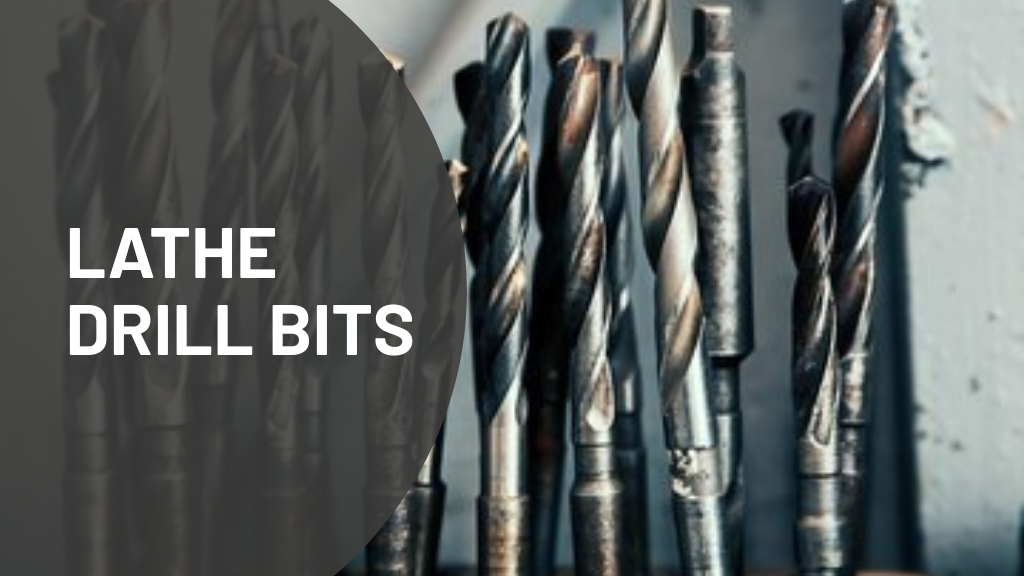The performance of a lathe machine largely depends on one small but critical component: the drill bit. Whether you are an experienced machinist or a beginner working with a small metal lathe, choosing the right lathe drill bits can make the difference between clean, precise cuts and wasted material.
Lathe drill bits are designed to withstand the unique demands of turning operations where the workpiece rotates while the tool remains fixed. Unlike conventional drilling where the tool spins, a lathe drill bit endures consistent contact, high friction, and continuous pressure. That is why using the right material and geometry for your drill bit is essential for quality machining.
This in depth guide will walk you through everything you need to know about metal lathe drill bits, steel lathe drill bits, lathe bit types, and even the best options for hardened steel. We will cover materials, geometry, coatings, real world applications, tips for extending tool life, and brand recommendations based on user experience. By the end, you will know exactly how to select the best lathe drill bits for your workshop or professional shop.
What Are Lathe Drill Bits
Lathe drill bits are cutting tools used to create holes in workpieces mounted on a lathe. Unlike milling or hand drilling, the lathe setup involves the workpiece spinning while the tool remains stationary in the tool holder or tailstock chuck.
A lathe drill bit must be designed to:
-
Withstand heat generated by constant friction.
-
Maintain sharpness during prolonged operations.
-
Handle varying cutting forces depending on material hardness.
-
Deliver precise holes without wandering.
These drill bits are commonly made of high speed steel, cobalt alloys, or carbide tipped materials. Each composition offers different advantages depending on the type of material being machined.
Types of Lathe Drill Bits
When it comes to lathe bit types, there are several options designed for different materials and cutting needs.
High Speed Steel Lathe Drill Bits
- Best for soft to medium strength metals like aluminum, brass, and mild steel.
- Affordable and easy to resharpen multiple times.
- Provide versatility for hobbyists and light industrial use.
Cobalt Lathe Drill Bits
- Contain 5 to 8 percent cobalt mixed with high speed steel.
- Excellent heat resistance, making them ideal for stainless steel and cast iron.
- Maintain hardness even at high drilling temperatures.
- More expensive but last significantly longer.
Carbide Tipped Lathe Drill Bits
- Extremely hard and resistant to wear.
- Excellent for drilling hardened steel and alloys.
- Produce smooth finishes but are brittle if mishandled.
- Commonly used in industrial and CNC environments.
Indexable Lathe Bits
- Use replaceable carbide inserts that can be swapped out when worn.
- Cost effective for high volume operations.
- Allow consistent performance without resharpening.
Specialty Lathe Drill Bits
- Center Drill Bits help in accurately starting holes.
- Spotting Drill Bits prevent wandering before deeper drilling.
- Step Drill Bits allow drilling of multiple hole diameters in one pass.
Material Considerations: Metal vs Steel vs Hardened Steel
The choice of drill bit depends on the hardness of the material being machined.
Lathe Drill Bits for General Metal Work
- High speed steel bits are suitable for softer metals such as aluminum or copper.
- Cobalt bits are the right choice for tougher materials like stainless steel.
- Carbide tipped bits excel in drilling extremely hard metals.
Lathe Drill Bits for Steel
Steel requires tougher bits that can resist heat and maintain sharpness. Cobalt bits are often preferred for most grades of steel while carbide tipped bits are necessary for hardened tool steels.
Lathe Drill Bits for Hardened Steel
Hardened steel is one of the most difficult materials to drill. Ordinary HSS bits dull almost instantly. For hardened steel:
- Use cobalt or carbide tipped drill bits.
- Apply consistent lubrication with cutting oil.
- Operate at lower speeds to minimize heat buildup.
Geometry of Lathe Drill Bits
The geometry of a drill bit plays a crucial role in how effectively it cuts through different materials. Every detail, from the tip angle to the shank design, influences speed, accuracy, and durability. Choosing the correct drill bit geometry ensures smooth machining and extends tool life, making it essential for both precision and efficiency.
-
118-Degree Tip Angle
A drill bit with a 118-degree tip angle is commonly used for softer metals and general-purpose drilling. Its sharper design allows for aggressive cutting, quick penetration, and faster results. However, it can sometimes wander if not properly aligned, so it works best when clamped or guided. This geometry is a reliable choice when productivity is more important than extreme accuracy.
-
135-Degree Split Point
For harder metals and tougher jobs, the 135-degree split point is the preferred option. This geometry minimizes the risk of drill walking, which improves accuracy and reduces rework. It also requires less downward pressure, making drilling smoother and more controlled. Professionals often use it when working with steel or alloys where precision and stability are essential.
-
Straight Shank Bits
Straight shank drill bits are highly versatile and compatible with most lathes. Their simple cylindrical design makes them easy to install and replace while offering consistent performance. They are widely used in both small workshops and larger machining environments. Because of their adaptability, straight shank bits are often the go-to choice for everyday drilling tasks.
Taper Shank Bits
Taper shank drill bits are designed for heavy-duty industrial applications that demand strength and stability. Their conical shape allows them to fit securely into the spindle, reducing slippage under load. This makes them ideal for larger diameters, high-pressure drilling, and continuous operations. When maximum power transfer and durability are required, taper shank bits are the professional standard.
Coatings That Enhance Performance
Modern lathe drill bits are not just about geometry. They also rely on advanced coatings to perform better and last longer. These coatings reduce friction, improve heat resistance, and increase overall efficiency during drilling. By selecting the right coating, machinists can achieve smoother operations, longer tool life, and more consistent results.
-
Titanium Nitride (TiN)
Titanium Nitride is one of the most common coatings used on drill bits. It creates a hard, golden layer that significantly improves wear resistance and cutting performance. TiN also reduces friction, which helps keep temperatures lower during drilling. This coating is best suited for general purpose use on softer metals and plastics.
-
Titanium Aluminum Nitride (TiAlN)
Titanium Aluminum Nitride is specifically designed for high speed machining. Its strong heat resistant properties allow drill bits to withstand extreme conditions without losing strength. TiAlN is especially effective when cutting hardened steels and alloys. It provides durability in demanding environments where standard coatings may fail.
-
Black Oxide
Black Oxide is a cost effective coating that enhances lubrication retention on the drill surface. It helps reduce friction between the tool and the material, leading to smoother drilling operations. This coating also offers a degree of corrosion resistance, extending tool life. It is widely used in workshops for everyday drilling applications.
-
Diamond Like Coating (DLC)
Diamond Like Coating is among the hardest protective layers available for drill bits. It provides exceptional wear resistance and allows drilling into extremely hard materials with minimal tool damage. DLC also reduces friction to near zero levels, which enhances precision. This coating is ideal for specialized applications where maximum strength and accuracy are required.
Best Lathe Drill Bits for Different Applications
Selecting the right lathe drill bit depends on the type of work you are doing. From hobby projects to professional machining and industrial operations, different materials and workloads demand specific drill bit types.
1. For Hobby Machinists
High speed steel drill bits are affordable and versatile. They provide solid cutting performance for softer metals, plastics, and wood. Brands such as Chicago Latrobe and Drill America are reliable choices that deliver great value for hobby use.
2. For Professional Machinists
Cobalt drill bits are the preferred option for professionals handling harder materials. Models like Irwin M35 and Norseman Drill are valued for their durability and heat resistance. These bits excel when drilling stainless steel and other tough alloys.
3. For Industrial Applications
Carbide tipped and indexable drill bits are the standard in heavy duty environments. They deliver superior performance, long tool life, and excellent heat resistance. Trusted manufacturers such as Sandvik, Kennametal, and Mitsubishi supply high performance options for industrial scale operations.
Case Studies and Real World Applications
Practical examples highlight how choosing the right drill bit improves efficiency, reduces costs, and extends tool life across different settings.
1. Small Workshop Example
A hobby machinist tried drilling stainless steel using ordinary HSS bits but noticed they dulled quickly after just a few holes. By switching to cobalt drill bits, the tool life increased dramatically. The machinist also achieved cleaner, more precise holes, making the upgrade well worth it.
2. Industrial Setting Example
In a CNC lathe shop, carbide tipped drill bits were paired with coolant while working on hardened steel shafts. This setup extended tool life significantly compared to standard bits. The reduced downtime for replacements helped maintain consistent production output.
3. Automotive Application Example
An automotive repair shop faced issues drilling exhaust manifold bolts made of hardened steel. Regular HSS bits failed repeatedly, causing delays. After switching to cobalt bits, the job was completed efficiently, saving both time and cost for the shop.
How to Choose the Best Lathe Drill Bits
Selecting the right lathe drill bits ensures accuracy, efficiency, and long-lasting performance. The right choice depends on material, design, machine compatibility, and budget. Below are the key factors to guide your selection.
-
Match Bit Material to Workpiece
The hardness of the workpiece should guide your choice of drill bit. Hardened steel requires cobalt or carbide bits, while softer metals can be drilled with high-speed steel (HSS). Using the right match improves efficiency and extends tool life.
-
Consider Cutting Geometry
Drill bit geometry impacts chip removal, heat management, and accuracy. Split-point and self-centering designs reduce walking, making them ideal for precision work. Selecting the right geometry helps achieve cleaner holes with less effort.
-
Check Lathe Compatibility
Not all drill bits fit every lathe chuck. Ensure the shank type and size match your machine for stability and safety. A secure fit reduces vibration, prevents tool damage, and produces more accurate results.
-
Balance Cost and Durability
Budget-friendly bits may suit occasional use, but frequent machinists benefit from investing in premium options. Carbide and cobalt bits offer longer life and resharpening potential, making them cost-effective in the long run.
Tips for Extending Drill Bit Life
To get the best performance and longevity from drill bits, proper care and usage are essential. Simple practices like lubrication, correct speed settings, and proper storage can greatly extend their lifespan.
-
Use Cutting Fluid
When drilling metals, always apply cutting fluid to reduce friction and heat. This improves cutting efficiency, prevents tool wear, and helps achieve smoother holes.
-
Adjust RPM to Material
Every material requires a specific spindle speed. Using the right RPM prevents overheating and ensures longer tool life. Harder metals need slower speeds, while softer ones can handle higher RPMs.
-
Avoid Excessive Pressure
Applying too much force can damage both the bit and the workpiece. Let the tool do the cutting while maintaining steady, controlled pressure to avoid overheating.
-
Sharpen HSS Bits Regularly
High-speed steel bits lose sharpness with frequent use. Resharpening them keeps performance consistent, reduces stress on the lathe, and saves money over time.
-
Store Bits Properly
Drill bits should be kept in protective cases to prevent damage. Proper storage reduces dulling, maintains alignment, and ensures they are ready for future use.
Common Mistakes to Avoid
- Using drill bits designed for wood on metal lathes, which can cause poor cuts and damage.
- Running the lathe at excessively high speeds without applying cutting fluid, leading to overheating.
- Continuing to drill with dull bits, which can harm both the tool and the workpiece.
- Choosing a drill bit geometry that is not suited for the material, resulting in inefficient cutting and rough holes.
Maintenance and Sharpening of Lathe Drill Bits
Proper maintenance is essential to keep your drill bits in working order.
- Resharpen HSS drill bits using a bench grinder, ensuring consistent cutting performance.
- Maintain the original cutting angle, typically 118 or 135 degrees, for optimal efficiency.
- Inspect each bit for cracks, chips, or other damage before every use to prevent accidents.
- Clean drill bits after use with a soft brush to remove metal shavings and debris.
Brand Comparisons
When selecting drill bits, the right brand often depends on your budget and application needs.
1. Budget Options
-
Drill America HSS sets are affordable and reliable for beginners.
-
Dewalt Titanium coated bits provide good value for mild steel.
2. Mid Range Options
-
Irwin cobalt drill bits offer excellent balance of cost and performance.
-
Norseman drills are highly rated among machinists.
3. Premium Options
-
Kennametal carbide tipped bits are known for industrial durability.
-
Sandvik indexable drills are preferred in CNC and production environments.
Conclusion
Lathe drill bits may seem like small tools but they determine the success of your machining process. Selecting the right drill bit for your lathe whether it is metal lathe drill bits, steel lathe drill bits, or lathe bits for hardened steel ensures cleaner cuts, longer tool life, and more efficient operations.
High speed steel remains a solid choice for soft metals and hobby use. Cobalt provides durability for steel and tough alloys. Carbide tipped and indexable bits are best for hardened materials and industrial machining.
Investing in quality drill bits is an investment in your productivity. With proper maintenance lubrication and correct cutting speeds your drill bits will last longer and deliver consistent performance. Whether you are a beginner or an experienced machinist understanding lathe bit types and their applications will give you a competitive edge in the workshop.
FAQs
What are the best lathe drill bits for hardened steel
Carbide tipped and cobalt drill bits are the most effective for hardened steel.
Can regular drill bits be used in a lathe
Yes but only if they are designed for metal work. Wood bits are not suitable.
How can I sharpen lathe drill bits
Use a bench grinder or a drill sharpening jig to maintain proper geometry.
Do I always need coolant when drilling steel
Yes coolant or cutting oil is recommended to reduce heat and extend tool life.
What is the difference between cobalt and carbide bits
Cobalt is tougher and resists heat while carbide is harder and best for extreme hardness but more brittle.




